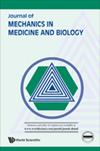Reliability of Static Balance Test in Faller and Nonfaller Parkinson Disease Patients
IF 0.6
4区 医学
Q4 BIOPHYSICS
引用次数: 0
Abstract
Little is known about the reliability of center of pressure (COP) variables during static balance test in patients with Parkinson’s disease (PD). Furthermore, reliability studies on fallers and nonfallers PD patients have not been explored. Therefore, our study investigated the test–retest reliability of COP outcome measures in faller and nonfaller PD patients. Eighty-one PD patients (49 nonfallers and 32 fallers) were recruited for measurement of static balance test. The patients maintained double-leg stance with feet on a force plate as stably as possible. To analyze the test–retest reliability of each COP outcome measures, intraclass correlation coefficient (ICC) statistical method was performed. Among COP outcome measures, mean velocity had the highest ICC value in faller patients ([Formula: see text]–0.915) and nonfaller patients ([Formula: see text]–0.960). Mean distance had excellent reliability in medio-lateral (ML) direction in both faller patients ([Formula: see text]) and nonfaller patients ([Formula: see text]). Ellipse area had excellent reliability in nonfaller patients ([Formula: see text]), but less reliability in faller patients ([Formula: see text]). Our results demonstrate that objective and quantitative balance assessment method is reliable in PD patients with or without a history of falls. On the other hand, it was not appropriate to use ellipse area to assess postural balance for faller PD patients. Our findings could be useful to develop an optimal balance protocol and apply appropriate COP outcome measures for PD patients.帕金森病患者静平衡试验的可靠性
对于帕金森病患者静力平衡试验中压力中心(COP)变量的可靠性了解甚少。此外,尚未对跌倒和非跌倒PD患者进行可靠性研究。因此,我们的研究调查了COP结果测量在跌倒性和非跌倒性PD患者中的重测信度。选取81例PD患者(非跌倒者49例,跌倒者32例)进行静态平衡测试。患者保持双腿站立,双脚尽可能稳定地放在受力板上。为分析COP各指标的重测信度,采用类内相关系数(ICC)统计方法。在COP结局指标中,跌倒患者的平均流速ICC值最高([公式:见文]-0.915),非跌倒患者的平均流速ICC值最高([公式:见文]-0.960)。在跌倒患者([公式:见文本])和非跌倒患者([公式:见文本])中,平均距离在中外侧(ML)方向上具有极好的可靠性。椭圆区域在非跌倒患者中具有良好的信度([公式:见文]),但在跌倒患者中可靠性较差([公式:见文])。我们的研究结果表明,客观定量的平衡评估方法对于有或没有跌倒史的PD患者是可靠的。另一方面,用椭圆面积评价跌倒性PD患者的姿势平衡是不合适的。我们的研究结果可能有助于制定最佳的平衡方案,并适用于PD患者适当的COP结果测量。
本文章由计算机程序翻译,如有差异,请以英文原文为准。
求助全文
约1分钟内获得全文
求助全文
来源期刊

Journal of Mechanics in Medicine and Biology
工程技术-工程:生物医学
CiteScore
1.20
自引率
12.50%
发文量
144
审稿时长
2.3 months
期刊介绍:
This journal has as its objective the publication and dissemination of original research (even for "revolutionary concepts that contrast with existing theories" & "hypothesis") in all fields of engineering-mechanics that includes mechanisms, processes, bio-sensors and bio-devices in medicine, biology and healthcare. The journal publishes original papers in English which contribute to an understanding of biomedical engineering and science at a nano- to macro-scale or an improvement of the methods and techniques of medical, biological and clinical treatment by the application of advanced high technology.
Journal''s Research Scopes/Topics Covered (but not limited to):
Artificial Organs, Biomechanics of Organs.
Biofluid Mechanics, Biorheology, Blood Flow Measurement Techniques, Microcirculation, Hemodynamics.
Bioheat Transfer and Mass Transport, Nano Heat Transfer.
Biomaterials.
Biomechanics & Modeling of Cell and Molecular.
Biomedical Instrumentation and BioSensors that implicate ''human mechanics'' in details.
Biomedical Signal Processing Techniques that implicate ''human mechanics'' in details.
Bio-Microelectromechanical Systems, Microfluidics.
Bio-Nanotechnology and Clinical Application.
Bird and Insect Aerodynamics.
Cardiovascular/Cardiac mechanics.
Cardiovascular Systems Physiology/Engineering.
Cellular and Tissue Mechanics/Engineering.
Computational Biomechanics/Physiological Modelling, Systems Physiology.
Clinical Biomechanics.
Hearing Mechanics.
Human Movement and Animal Locomotion.
Implant Design and Mechanics.
Mathematical modeling.
Mechanobiology of Diseases.
Mechanics of Medical Robotics.
Muscle/Neuromuscular/Musculoskeletal Mechanics and Engineering.
Neural- & Neuro-Behavioral Engineering.
Orthopedic Biomechanics.
Reproductive and Urogynecological Mechanics.
Respiratory System Engineering...
 求助内容:
求助内容: 应助结果提醒方式:
应助结果提醒方式:


